Tens of millions of students still don’t have internet access at home. And that is the case even though schools are still asking students to get a good chunk of their homework done online after school.
What makes the situation even worse for students is that fewer school districts are helping pay for students’ home internet now that full-time remote and hybrid learning are mostly in the rearview mirror.
Education Week spoke with Jack Lynch, the chief operating officer for EducationSuperHighway, a nonprofit internet access advocacy organization, about the vital role schools and districts can still play in keeping families connected to the internet.
This interview has been edited for length and clarity.
There has been a steep drop in the number of schools offering home internet to students whose families can’t afford it. What are the consequences of this shift?

During the crisis of the pandemic, schools saw this as something they needed to step in and do, but now that we’re getting back to normal, schools are reopened, kids are back in the classroom, the issue isn’t going away. And the issue is that about 15 million students during the pandemic didn’t have internet access at home and we know that’s still a problem.
We’re not exactly sure how much that number has changed since then, but there is a sizable number of students who still don’t have internet access at home.
I think the challenge is that schools aren’t sure what their role is in terms of making sure that a student has internet access at home.
Without COVID aid dollars, will there be more federal money coming in to help families?
Yes, there is. The Affordable Connectivity Program was part of the Infrastructure [Investment] and Jobs Act. And it provides a $30 dollar discount on monthly internet bills for qualifying households. So, if you’re enrolled in Medicaid, you’re eligible, or if you have a child who receives free or reduced priced lunch at school, that is another qualifying program. Then there is also income-based qualification.
Another important aspect of this is that in concert with the White House and the federal government, a number of internet service providers across the country have committed to offering $30 a month or less plans for households who qualify, which means that this will essentially be free if you are eligible for the ACP and you choose one of those plans.
What role should schools play in keeping students connected to the internet at home?
The thing schools are really set up to do is to be the trusted messengers to their families and households about the ACP and pointing them to how they can apply for it.
Awareness about the ACP is very low nationally. Only about 25 percent of eligible households are even aware that the program exists. Without being aware that the program exists, you’re never going to sign up for it.
We have a resource on our website, on EducationSuperHighway.org called the Affordable Connectivity Program adoption toolkit for school districts. It’s basically a playbook for how districts can reach out to their unconnected families and give them the information they need to sign up for the ACP.
Has the pandemic changed the expectations around what students should be able to do from home?
Absolutely. Teachers, schools have really embraced technology as a result of the pandemic. The schools are open again, but the technology is staying. As the whole K-12 ecosystem has gotten more comfortable with technology in the classroom, digital learning, using these digital tools to help administer education—which is a good thing overall, right?—but we need to make sure every student can access it equally and equitably. This was a problem before the pandemic, people referred to it as the “homework gap"—the number of students who couldn’t do their homework at home.
The consequences of not having internet at home have only increased now for students caught in that divide.
Is there a pandemic silver lining in terms of the number of kids now connected? Are we still at a higher level of connectivity than the pre-pandemic baseline?
We most certainly are. If the number was 15 million at the beginning of the pandemic, all these efforts have connected probably millions of households, whether that’s through the Emergency Connectivity Fund, or the ACP, or even hotspots, which are better than nothing. More people are connected now than ever before, but if we don’t transition into sustainable solutions, then we might go backwards.






